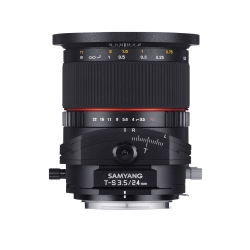
Samyang MF 24mm F3,5 T/S Sony A
- Professional 24 mm wide angle tilt and shift lens for Sony A bayonet, full frame, also for APS-C
- Ideal for architectural, landscape and object photography as well as artistic photography
- Tilt to ± 8,5°, with adjusting and locking screw, rotatable by 90°, with detents every 30°
- Shift up to ± 12 mm, with adjusting and locking screw, rotatable by 90°, with detents every 30°
- Excellent imaging quality up to the image edges, high lens speed of f/3.5
- Manually adjusting focus and aperture
- 16 coated glass lenses, including two aspherical (ASP) and two ED lenses
- Filter thread 82 mm
- Incl. lens bag and protective cap
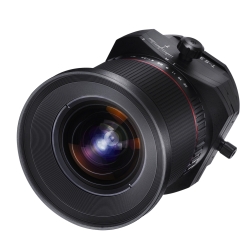
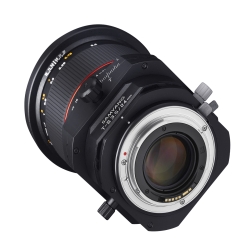
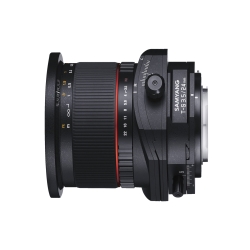
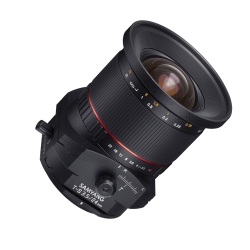













Creative image design with Tilt and Shift
In photography, Tilt and Shift are two separate technologies with different effects that are often combined in one tilt shift lens. In the past, these effects could quite easily be achieved with bellows cameras. The Samyang MF 24mm F3.5 DSLR T/S Tilt-Shift lens offers these two functions in one high-quality lens.
The Shift function compentsates perspective distortion. With this function, the front of the lens is shifted up or down relative to the base. The optical path changes in that the optical axis no longer leads vertically from the sensor through the lens to the front, but diagonally from the sensor through the offset front lens of the front part of the lens, for example diagonally upwards.
With normal lenses, one would simply pan the camera upwards for this section of the picture, but in doing so the perspective is distorted - a photographed building seems to tip backwards. With the shift function, on the other hand, the alignment of the sensor (the image plane) remains parallel to the object (the subject plane), only the image axis is tilted. This means that the optics also correspond to those of a "normal" photo. The shift function is often used in landscape and architectural photography to prevent falling lines, as perspective distortion is called too, but can also be used for portraits.
The Tilt function on the other hand tilts the focus plane in relation to the sensor plane. This tilts the front of the lens relative to the base. The optical axis continues to run straight through all the lenses, and the image content also changes ever so slightly in contrast to the shift function, but the focal plane itself is now tilted.
With a regular lens, the focal plane is always parallel to the sensor plane. With a tilt lens, the focus plane can be offset to the sensor plane for the requirements of the image. If, for example, a complete train is to be photographed with a shallow depth of field so that a beautiful bokeh sets the train apart from the background, the photographer can use the tilt function to place the focal plane along the tracks so that the rear end of the train will not be the blurred area. With a normal lens he (or she) can only achieve this if he is at a right angle to the tracks. The Tilt function is also suitable for product shots, paintings or house fronts.
To enable the tilt and shift function in all directions, both the tilt and shift levels can be rotated separately in 30° steps by up to 90°. This means that the focus plane can also be tilted sideways or at an angle, and the image plane can also be shifted sideways when rotated. The entire lens (i.e. tilt and shift) can be rotated to the right, the tilt section to the left.
Miniature effect through tilt and shift
With the tilt function it is also possible to create the popular miniature effect. To make a scene look like a small model, it is necessary to know why a model looks like a model in the first place.
In three-dimensional vision, the distance between the eyes determines how small the rest of the world is perceived. The further the "eyes" of the two cameras are apart, the smaller what is seen appears. The larger parallax creates the impression for our brain, which is accustomed to our human eye distance, that the rest of the world has become smaller, since the angle of vision of all objects changes and we can see more of their otherwise hidden sides. This is often used in 3D photography and 3D filming.
However, if you want to achieve a comparable effect with just one camera, you use a shallow depth of field instead to suggest that you are looking at something small and close as a giant. For this purpose, the focal plane has to be tilted so that the image acquires two blurred areas - one in front of and one behind the focused area. These suggest that the respective partial area is too close or too far for us "giants" to be able to see it sharply, as we "concentrate" on the middle area. However, the subject must also be suitable for this manipulation - after all, the photo must trick the brain.
With a tilt-lens you turn the focal plane so that it tilts towards the camera (like the screen of a laptop when you close it) - you swivel the front of the lens upwards. This gives you the look that makes the subject look like a miniature.
The rule of thumb for miniature shots is that they work best from a highly elevated point of view, i.e. with a look down at the miniature - just like you look at a scale model. Then the focal plane must be tilted parallel to the ground, the blur must be at the top and bottom, because anything else does not correspond to natural vision and irritates. Nothing should protrude significantly into the focused area - giant leaves the size of football fields hanging into the focus plane will immediately ruin the illusion. Things that protrude out from the focus area, such as power poles or trees, also become blurred halfway up, which of course also irritates, since they are actually in the focus area as far as the giant analogy is concerned and should therefore remain sharp.
The vertical format is rather unsuitable for miniature photography, as the natural field of view of humans is the landscape format. For artistic effects and creative photography, of course, anything is allowed. For example, you can use the tilted focus plane to create fascinating portraits that only focus on the subject's eyes.
"Tilt, Shift and Focus" with clearly arranged controls
The wide-angle lens offers a fixed focal length of 24mm and a high speed of f/3.5. A total of 16 coated lenses (including two aspherical and two ED lenses) ensure a good image quality. Aperture adjustment and focusing are done manually. With the black rotary knobs you adjust the optics, both tilt and shift. The grey rotary knobs lock the selected setting to prevent unintentional adjustment.
The entire optics can be rotated with the aid of two small, flat, grey release buttons close to the bayonet. Both the tilt and shift functions can be rotated separately in 30° increments of up to 90° each. This gives you the freedom not only to shift upright, but also diagonally or sideways, as well as to tilt upright, diagonally or sideways. By combining these ranges, you can cover any position of the lens in the full circle, but also achieve any desired combination of tilt and shift direction.
Advantages of a full frame lens on a camera with APS-C sensor (or smaller)
Save time in post-processing: A variety of lens defects such as distortion, blur, or vignetting appear on the edges of the image. If you use a full-frame lens on a camera with an APS-C sensor, these areas will not be used in the first place. Thus, you automatically get the maximum quality and no additional time for correcting lens errors needs needs to be invested in post-processing.
General information
| Product Type | Lens |
| Material | Aluminium, Synthetic material, Glass |
| Product Color | Black |
| Length | 109mm |
Specifications
| Lens connection | Sony A |
| Developed for | Full Frame |
| Suitable for Sensor | APS-C, Full Frame |
| Crop Factor | 1,5 |
| Focal Distance | 24mm |
| Lens Speed | 1:3,5 |
| Internal Focusing | Yes |
| Lenses / Groups | 16 / 11 |
| Number of Aperture Slats | 6 |
| Coating | UMC - Ultra Multi Coating |
| Minimum Focusing Distance | 0,2m |
| Lens Diameter | 86mm |
| Filter Diameter | 82mm |
| Body material | Metal and Plastic Combination |
| Angle of View | 56,9° |
| Type | Tilt Shift |
| Category | Tilt Shift |
| Field of Application Lens | Architecture, Countryside, Art, Nature |
| Camera Model | Sony Alpha SLT-A77 II, Sony Alpha SLT-A58, Sony Alpha SLT-A37, Sony Alpha SLT-A57, Sony Alpha SLT-A35, Sony Alpha SLT-A33, Sony A100, Sony A200, Sony A230, Sony A290, Sony A300, Sony A330, Sony A350, Sony A380, Sony A390, Sony A450, Sony A500, Sony A550, Sony A560, Sony A580, Sony A700, Sony A850, Sony A900, Sony A99 II |
| Usage | Photo |
Packaging
| Girth | 730mm |
| Height of Packaging | 131mm |
| Length of Packaging | 198mm |
| Packaging Material | Colour Packaging |
| Packaging with Euro Hole | No |
| Weight incl. Packaging | 655g |
| Width of Packaging | 133mm |
- 1x Samyang 24/3.5 Tilt-Shift Lens for Sony A
- 1x Lens hood
- 2x Lens cap (front and rear)
- 1x Lens protection bag
- 1x Manual